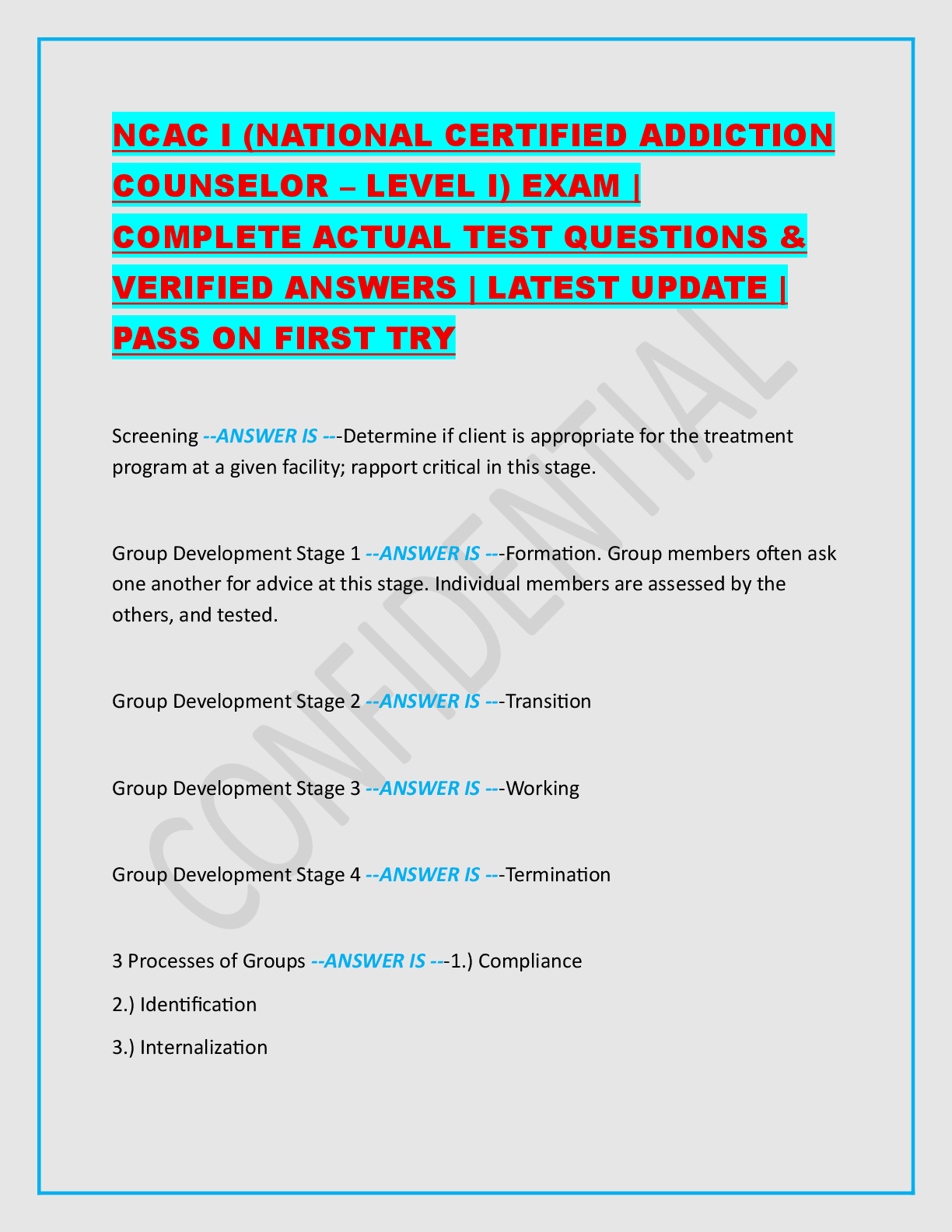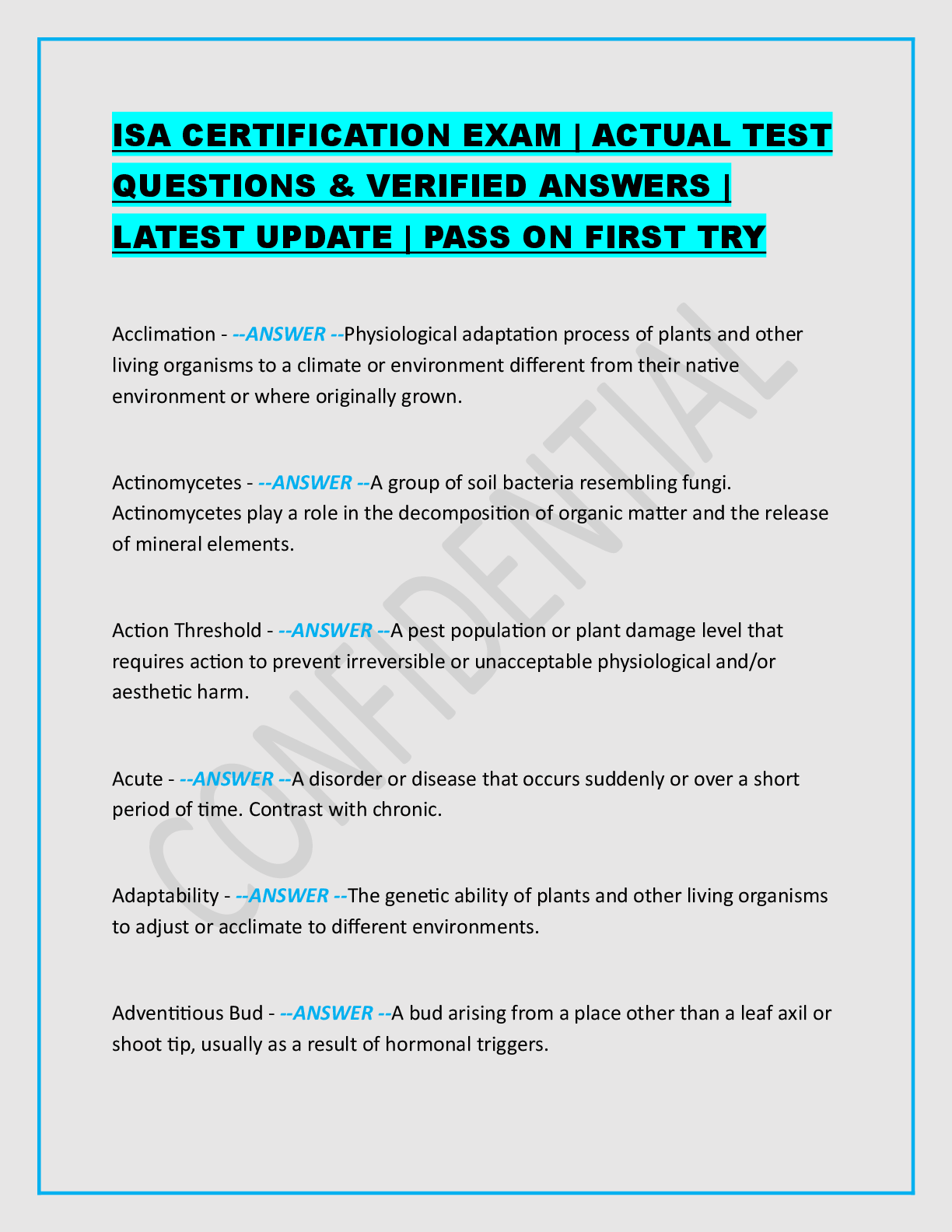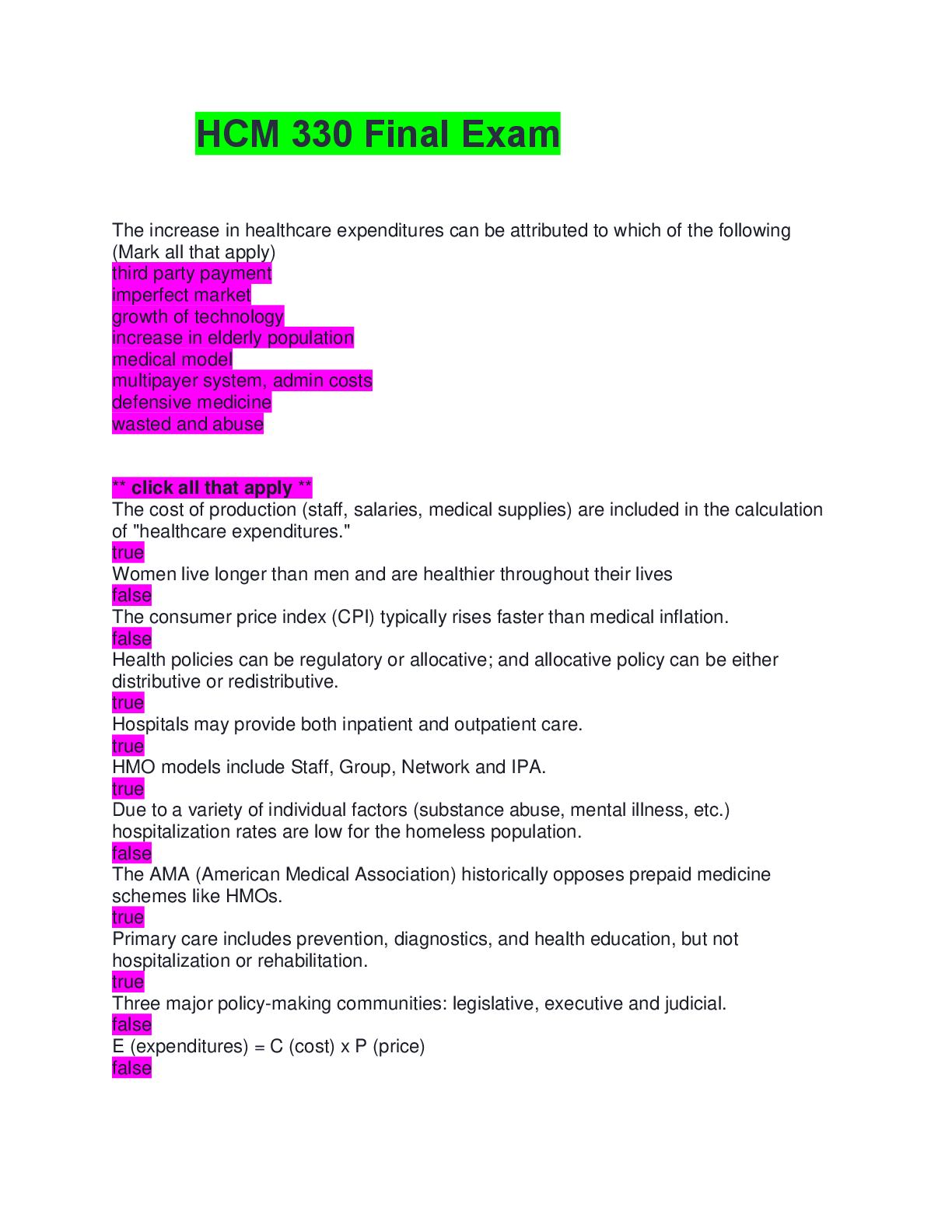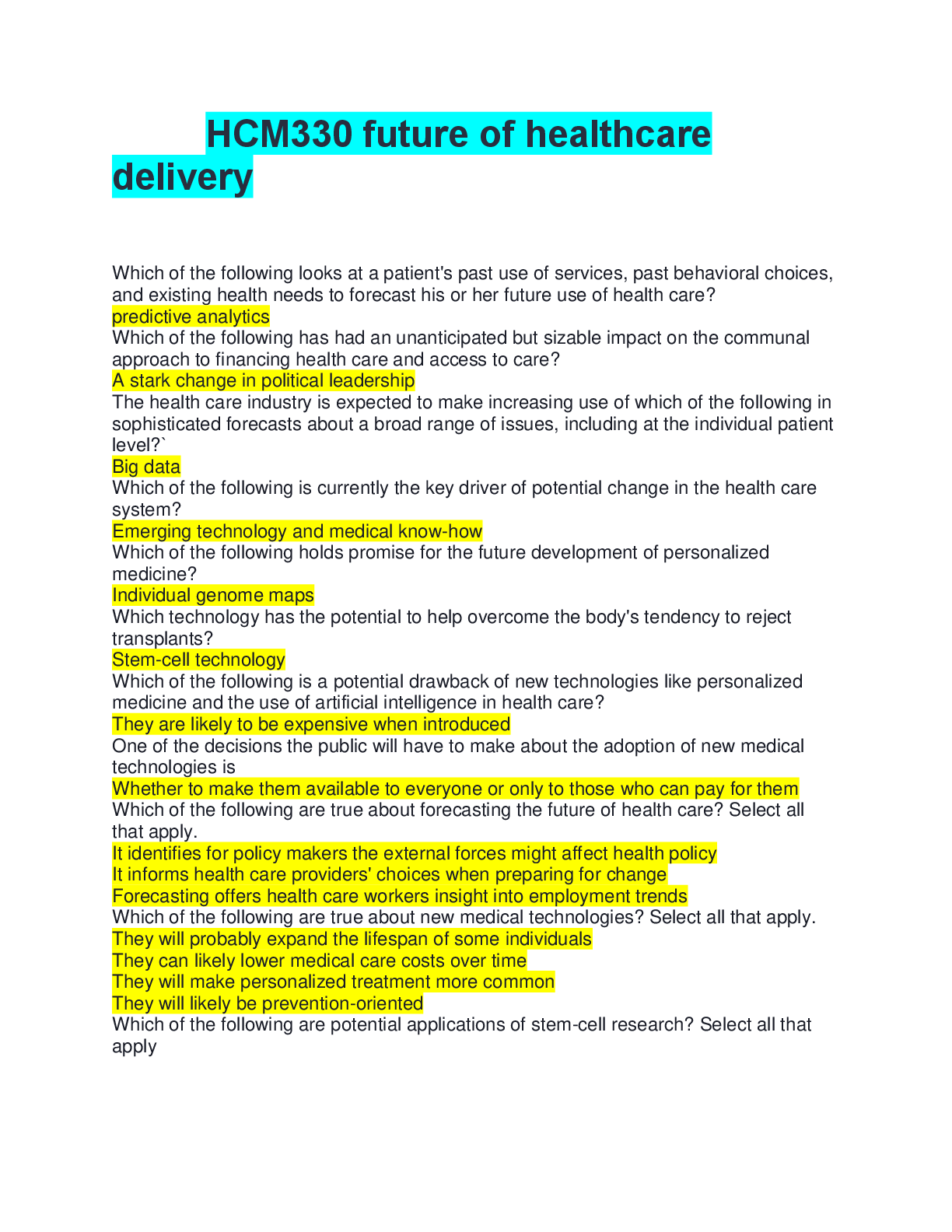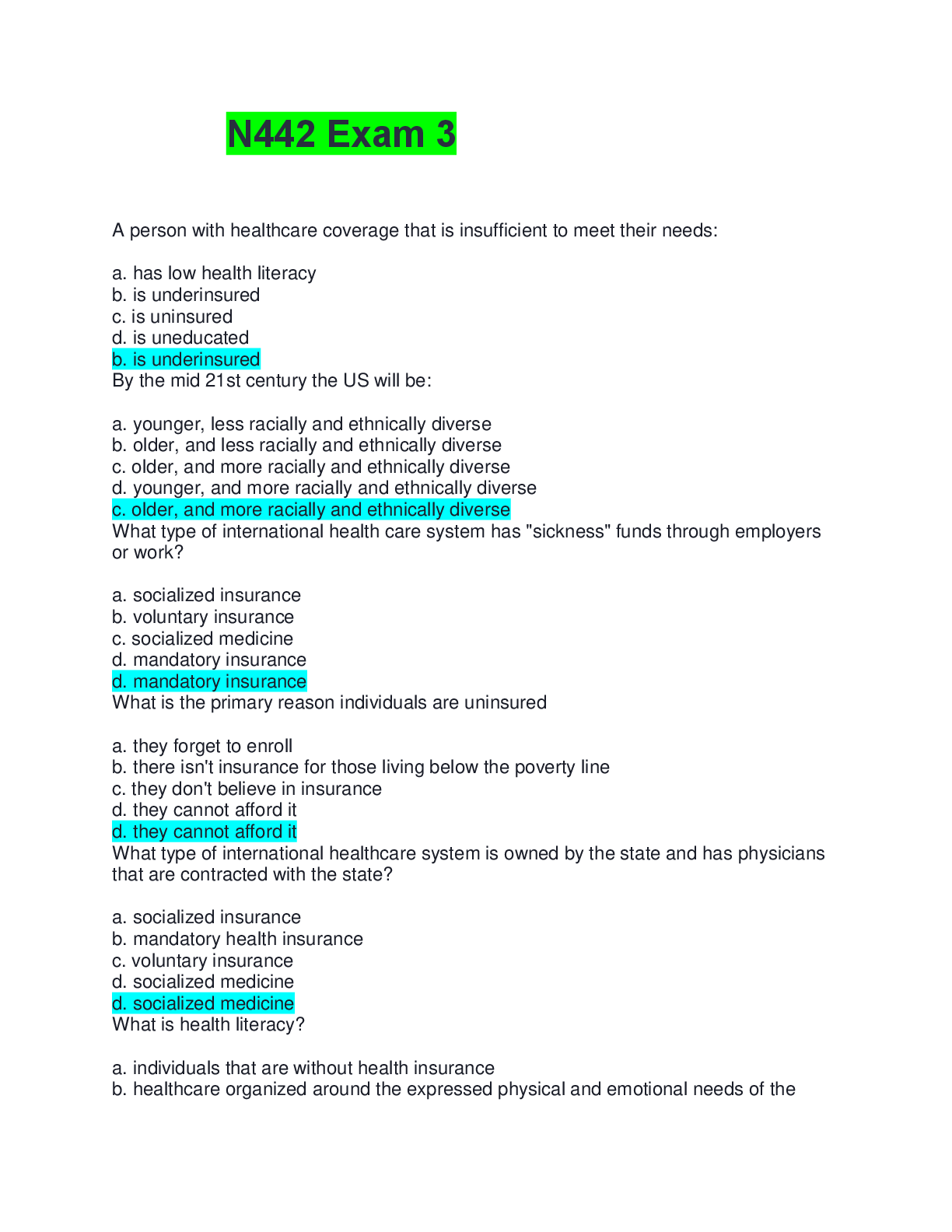Pathophysiology > EXAMs > WGU Pathophysiology D236 Exam Latest updated Graded A+ (All)
WGU Pathophysiology D236 Exam Latest updated Graded A+
Document Content and Description Below
Describe how your body responds to an infection. - ANSWER T cells produce cytokines, which stimulate B cells. B cells produce antibodies. Identify role of DNA changes in congenital abnormalities. - ... ANSWER Mutations in genes or chromosomal abnormalities How does development disrupts congenital abnormalities? - ANSWER Alterations of DNA Describes factors that disrupt homeostasis and how disruptions affect wellbeing. - ANSWER (ex) Fluid and electrolyte shifts can cause n/v or dysrhythmias. Explain RAAS - ANSWER Renin-angiotensin-aldosterone system 1. Reduce blood flow causes kidneys to release renin > produce angiotensin I > converts angiotensin I to angiotensin II > vasoconstriction > release aldosterone > kidneys conserve sodium and water > Result less water lost in urine and blood pressure maintained. DKA - ANSWER increased anion gap, decreased HCO3 How do kidneys compensate for alkalosis - ANSWER retain H and excrete HCO3 Untreated acidosis leads to an increase in which electrolyte? - ANSWER Potassium West Nile Virus - ANSWER Transmitted through the bite of an infected mosquito. Severe signs and symptoms; high fever, headache and stiff neck Lyme disease - ANSWER Tick-borne disease caused by the spirochete Borrelia burgdorferi. Erythema infectiosum - ANSWER a febrile upper respiratory illness in a child followed by the sudden appearance of red, flushed cheeks, "fifth disease" Obesity ad diabetes are risk factors for having a child with _____. - ANSWER Spina bifida Trousseau's sign - ANSWER arm/carpal spasm associated with hypocalcemia Cause and sign of spina bifida - ANSWER results from failure of neural tube to close. sign - fluid filled sac on lower back. hemophilia is more common in - ANSWER males Prenatal exposure to alcohol includes - ANSWER ND-PAE, decreased brain function, FAS Connective vs muscle tissue disorders - ANSWER Connective- RA, Scleroderma, Lupus Muscle - MS, Muscular dystrophy, Myasthenia Gravia Describe Lupus - ANSWER Inflammatory disorder characterized by joint pain and butterfly rash Describe Myasthenia Gravis - ANSWER It is an autoimmune disorder where antibodies attack own Ach receptors. This causes weakness of skeletal muscles over the course of the day, along with ptosis, double vision, and difficulty swallowing. dermatitis - ANSWER inflammation of the skin eczema - ANSWER noninfectious, inflammatory skin disease characterized by redness, blisters, scabs, and itching decubitus ulcer - ANSWER sore caused by lying down for long periods of time Fungal infections - ANSWER superficial, localized skin conditions or deep tissue infections caused by exposure to spores may or may not be transmitted benign neoplasm - ANSWER noncancerous growths, stationary, distinct borders malignant neoplasm - ANSWER uncontrolled new tissue growth, irregular borders, spreads Osteoporosis - ANSWER The loss of bone mass often due to age, causing the bones to become porous, brittle, and easily fractured. osteomalacia - ANSWER disease marked by softening of the bone caused by calcium and vitamin D deficiency myoglobin - ANSWER red pigment that stores oxygen in muscle cells Bursa - ANSWER fluid-filled sac that allows for easy movement of one part of a joint over another Rickets - ANSWER a vitamin D deficiency in children, resulting in soft bones Degenerative disk disease - ANSWER A condition in which an intervertebral disk loses its normal structural integrity as a result of wear and tear, acute or repeated injuries or aging Paget disease - ANSWER Chronic inflammation of bones, resulting in thickening and softening of bones, that can occur in any bone but most commonly affects the long bones of the legs, the lower spine, the pelvis, and the skull communiuted fracture - ANSWER splintered into many pieces Three types of skin cancer - ANSWER 1. Basal cell carcinoma 2. Squamous cell carcinoma 3. Melanoma basal cell carcinoma - ANSWER Most common and least severe type of skin cancer; often characterized by light or pearly nodules. Rarely metastasize, most common on face due to sun exposure squamous cell carcinoma - ANSWER Type of skin cancer more serious than basal cell carcinoma; often characterized by scaly red crusted papules or firm nodules. Melanoma - ANSWER The most serious form of skin cancer, caucasian males at highest risk, usually black or brown lesion consequences when integumentary system is disrupted - ANSWER impaired immunity types of burns - ANSWER Superficial (1st degree) - red/painful Partial-thickness (2nd degree) -wet/pink/painful Full-thickness (3rd degree) -white/swollen/no pain Viltigo - ANSWER localized loss of skin pigmentation characterized by milk-white patches ischemic CVA vs hemorrhagic CVA - ANSWER ischemic - clot vs hemorrhagic - blood subdural hematoma - ANSWER collection of blood under the dura mater Alzheimer's disease vs parkinson's disease - ANSWER Alz - affects language and memory Park - affects all executive functioning Huntington's disease - ANSWER Genetic disorder that causes progressive deterioration of brain cells. caused by a dominant allele. symptoms do not appear until about the age of 30. involves involuntary muscle movement Sclerosis - ANSWER abnormal condition of hardening disorders that cause vision loss - ANSWER glaucoma - loss of pheripheral vision, cataracts - cloudy vision, retinal detachment - floaters, flashes, curtain vision kyphosis - ANSWER excessive outward curvature of the spine, causing hunching of the back. [Show More]
Last updated: 3 years ago
Preview 1 out of 13 pages

Buy this document to get the full access instantly
Instant Download Access after purchase
Buy NowInstant download
We Accept:

Reviews( 0 )
$8.00
Can't find what you want? Try our AI powered Search
Document information
Connected school, study & course
About the document
Uploaded On
Oct 15, 2022
Number of pages
13
Written in
All
Additional information
This document has been written for:
Uploaded
Oct 15, 2022
Downloads
0
Views
74
















